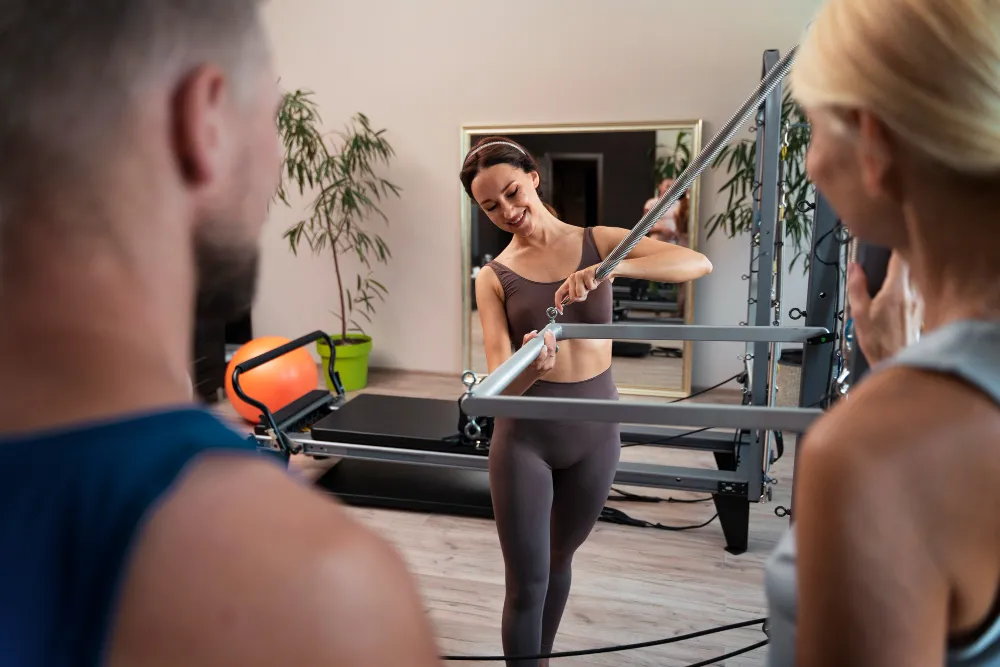Table of Contents
The Shifting Landscape of Fitness in Ireland
Fitness trends in Ireland are evolving rapidly, reflecting a global shift towards more adaptable and personalised fitness experiences. The traditional model of gym attendance—where members visit a physical location to work out—is being augmented by innovative, digital solutions. This transition has given rise to the concept of hybrid gyms, which blend in-person and online fitness offerings.
What are Hybrid Gyms?
Hybrid gyms offer a flexible model, allowing members to access services both in-person and online. You can join live classes from home, work out in your hotel room, or visit the gym. This caters to evolving fitness needs and incorporates cutting-edge technology.
Hybrid gyms, also known as omnichannel gyms, provide a flexible fitness model that allows members to access gym services both physically and digitally. This means you can join a live class from the comfort of your home, participate in a session from your hotel room while travelling, or hit the weights in a physical gym location. This approach not only caters to the changing demands of fitness enthusiasts but also integrates the latest technological advancements to enhance the workout experience.
These gyms are quickly becoming a cornerstone of modern fitness in Ireland, driven by the growing demand for more accessible and personalised fitness solutions. As we dive deeper into this topic, we’ll explore how these changes are reshaping the way people in Ireland exercise and the broader implications for the fitness industry.

The Rise of Hybrid Gyms
Hybrid gyms, which blend in-person and online fitness options, are becoming a significant part of Ireland’s fitness industry landscape. This section explores what hybrid gyms are and the growth data that highlight their rise both in Ireland and globally.
Growth in Ireland and Globally
The trend towards hybrid gyms has been accelerating, particularly as the world adapts to the changes brought about by the COVID-19 pandemic. In Ireland, as gym attendance nears pre-pandemic numbers, there’s a noticeable shift in how people choose to engage with fitness facilities. Many individuals now appreciate the convenience of accessing fitness both physically and digitally, which is evident from the increasing number of gyms offering hybrid memberships (TeamUp).
Globally, the fitness industry is observing a similar trend. The demand for digital fitness solutions soared during the pandemic, and it has not waned. Even as gyms have reopened, many people continue to take advantage of online workout options, leading to a permanent change in consumer behaviour (TeamUp).
This growth is supported by technology advancements that make remote fitness more interactive and engaging. Apps and online platforms are increasingly sophisticated, offering everything from live workouts with real-time feedback to VR experiences that mimic being in a studio class.
The hybrid gyms represent a significant evolution in the fitness industry, driven by changing consumer preferences and technological innovations. In Ireland, this trend is not just a reaction to recent global events but a forward-looking adaptation to the future of personal health and fitness.
Why Hybrid Gyms are Gaining Popularity
Hybrid gyms, which combine in-person and digital fitness options, are rapidly gaining traction in Ireland. This rise in popularity can be attributed to several key factors:
Convenience and Accessibility
Hybrid gyms offer unprecedented convenience, allowing members to participate in workouts either from the comfort of their homes or at physical gym locations. This flexibility is especially appealing in today’s fast-paced world, where balancing work, personal life, and fitness can be challenging. For instance, someone with childcare responsibilities can attend an online class during their child’s naptime, or a busy professional can squeeze in a virtual session during a lunch break without needing to travel to a gym.
Personalisation Through Technology
The integration of advanced technologies such as artificial intelligence (AI) and mobile applications allows hybrid gyms to offer highly personalised workout experiences. These technologies can tailor fitness programs to individual needs based on their fitness levels, goals, and preferences. For example, AI algorithms can suggest workouts that are most effective for a person’s specific body type and fitness goals, enhancing the effectiveness of the exercise regimen.
Broader Appeal
Hybrid gyms cater to a wide demographic. They are not only appealing to tech-savvy millennials but also to older adults who may prefer low-impact exercises that can be done at home. The versatility of hybrid gyms means they can offer a range of classes catering to various interests and abilities, from high-intensity interval training (HIIT) for those looking for a challenge to gentle yoga and pilates for those focusing on flexibility and strength without strain.
The benefits of hybrid gyms extend beyond just physical health. They also offer a psychological advantage by providing a sense of community through live online classes where participants can interact with instructors and fellow gym-goers in real-time. This can be particularly motivating and helps maintain accountability, which is often missing in purely online formats.
Technological Innovations Driving the Trend
The integration of cutting-edge technologies into the fitness industry, particularly within hybrid gyms such as Gym in Naas, is not just a novelty but a significant shift towards more immersive and personalised fitness experiences. Here are some key technologies making an impact:
1. Virtual Reality (VR) and Augmented Reality (AR):
- VR and AR Applications: These technologies are transforming traditional workout environments into interactive and engaging spaces. VR headsets can transport users to virtual settings, making a stationary bike ride or a treadmill run a visually stimulating experience. For instance, platforms like ICAROS provide equipment that integrates VR for an immersive workout, simulating environments from flying through the sky to deep sea diving (WellnessLiving).
- Benefits: The immersive nature of VR and AR can make workouts more enjoyable and less monotonous, potentially increasing user engagement and workout frequency.
2. Fitness Tracking and Gamification:
- Tracking Technologies: Wearable devices and fitness trackers are now more sophisticated, capable of monitoring heart rate, calories burned, and even sleep patterns. This data is invaluable for tailoring fitness programs to individual health metrics and goals.
- Gamification Elements: Many fitness apps incorporate elements of gamification such as challenges, badges, or leaderboards to motivate users. This approach not only makes the workout fun but also fosters a sense of community and competition (WellnessLiving).
3. AI-driven Personalisation:
- Customised Workout Plans: AI algorithms are increasingly used to analyse user data and provide personalised workout and nutrition recommendations. These can adjust in real-time based on the user’s performance and feedback, ensuring that each session is optimized for maximum benefit (WellnessLiving).
- Integration in Equipment: Some gym equipment now features built-in AI that can suggest adjustments to form, count repetitions, and even predict when a user might be at risk of injury, enhancing both safety and effectiveness.
4. On-Demand Fitness Classes:
- Streaming Services: Hybrid gyms often offer a library of on-demand classes that can be accessed anytime from anywhere. This flexibility allows users to fit exercise into their schedule conveniently, a key appeal of the omnichannel approach.
- Interactive Elements: Live streaming classes where instructors can provide real-time feedback to online participants help mimic the interactive experience of in-person classes, bridging the gap between digital and physical workout spaces.
These technological innovations are crucial in evolving the traditional gym into a more dynamic, responsive, and inclusive environment. They cater not only to fitness enthusiasts looking for an edge in their workout routines but also to newcomers seeking engaging and accessible ways to improve their health and wellness. As these technologies continue to develop, they will likely become even more integrated into the day-to-day operations of gyms and fitness centres, further shaping the future of exercise in Ireland and beyond.

Benefits of Hybrid Gyms
Hybrid gyms, which combine in-person and digital workout options, are transforming the fitness landscape in Ireland. Here are some key benefits of this evolving model:
Flexibility and Variety in Workout Options
Hybrid gyms offer unprecedented flexibility in how, when, and where members can exercise. Members can choose to attend a class in person, participate from home via a live stream, or use on-demand video workouts at their convenience. This flexibility is especially appealing to those with unpredictable schedules, such as shift workers or parents who might find it challenging to fit a gym visit into their daily routine. The variety of options available—ranging from high-intensity interval training (HIIT) to yoga and strength training—ensures that there is something suitable for every fitness level and interest.
Enhanced Engagement and Motivation
One of the standout features of hybrid gyms is the use of gamification and community engagement strategies. Gamification, which might include fitness challenges, leaderboards, and reward systems, makes exercising more interactive and fun. This approach not only makes workouts engaging but also motivates members to consistently participate and push their limits. Additionally, the community aspect of hybrid gyms—whether through live-streamed classes that allow for real-time interaction or through forums and group chats—helps build a sense of belonging and accountability among members, which can lead to sustained engagement and adherence to fitness routines.
Potential for Higher Retention Rates
Hybrid gyms address many of the common barriers to regular gym attendance, such as lack of time, proximity issues, or the intimidation factor that some individuals feel in a traditional gym setting. By providing multiple avenues for participation, hybrid gyms cater to a wider audience, thus enhancing member satisfaction and potentially increasing retention rates. Members who can workout how and when they prefer are likely to continue their memberships longer than those who might feel constrained by less flexible options. Furthermore, the personalized touch that technology allows—tailoring workouts and nutrition advice to individual needs—can make members feel valued and more closely connected to their gym, reinforcing their commitment to their fitness journeys.
Overall, hybrid gyms represent a significant shift in the fitness industry, offering a more inclusive, engaging, and adaptable approach to maintaining physical fitness. This model not only meets the current demands of consumers but also sets the stage for future innovations in how fitness services are delivered.
Challenges and Considerations for Hybrid Gyms
Hybrid gyms, which combine online and in-person fitness experiences, are transforming the fitness landscape. However, this innovative approach comes with its own set of challenges and considerations that need to be managed carefully:
Initial Investment in Technology
- Setup Costs: Establishing a hybrid gym requires significant upfront investment in technology. Gyms need to procure hardware for digital workouts, such as screens and cameras, and software for streaming and customer management.
- Ongoing Maintenance: Technology is not only expensive to install but also to maintain. Regular updates and technical support are necessary to ensure a seamless user experience.
Seamless Integration of Services
- User Experience: One of the biggest challenges is creating a user-friendly interface that integrates both physical and digital offerings. This includes ensuring that booking systems, workout tracking, and customer support are accessible and efficient.
- Connectivity Issues: Gyms must have reliable internet connections to stream high-quality video content. Poor connectivity can lead to disrupted classes and a negative user experience.
Maintaining Personal Connection
- Human Element: As gyms incorporate more technology, there’s a risk of losing the personal touch that many members value. It’s crucial to balance tech solutions with human interaction.
- Trainer Engagement: Instructors must be trained not only in fitness but also in engaging members through digital platforms. They need to be able to motivate and connect with members who are not physically present.
Data Privacy and Security
- Member Data: With gyms collecting more personal data to offer customised workouts, there is an increased responsibility to protect this information against breaches.
- Compliance: Gyms must ensure they comply with data protection regulations such as GDPR, which governs how personal information is collected, stored, and used.
Adaptability to Market Changes
- Evolving Consumer Preferences: Fitness trends can change rapidly. Gyms must stay adaptable and continuously update their offerings to keep up with new fitness preferences and technologies.
- Competition: As more gyms adopt the hybrid model, the competition intensifies, pushing gyms to innovate continuously to distinguish themselves from others.
Future Considerations
Looking forward, gyms will need to continue adapting to the evolving technological landscape and changing customer needs. This might involve investing in more advanced technologies, such as AI-driven personal trainers or incorporating new fitness trends into their offerings more swiftly.
By navigating these challenges successfully, hybrid gyms can provide a comprehensive and engaging fitness experience that meets the needs of a diverse clientele, ensuring their place in the future of fitness.

Future of Fitness in Ireland
As Ireland’s fitness industry embraces hybrid gyms, the evolution of this sector seems poised for further innovative leaps. Here’s a look at some potential future trends and the growing significance of adaptable fitness models:
- Increased Personalisation Through Advanced Technology: The future could see an even greater use of artificial intelligence (AI) and machine learning to provide highly personalised fitness programs. These technologies could analyze real-time data from wearable devices to adjust workouts instantaneously based on a user’s performance and health indicators.
- Integration with Health Monitoring: Beyond fitness, hybrid gyms might integrate more closely with health monitoring systems. This could involve tracking not just fitness metrics but also vital signs and other health indicators, providing a holistic view of a person’s well-being. This integration could aid in preventative health care by alerting users and their health providers to potential health issues before they become serious.
- Sustainability in Gym Operations: As environmental concerns continue to grow, future fitness facilities could focus more on sustainability. This might include using eco-friendly materials and technologies, promoting lower energy consumption, and even incorporating outdoor activities that encourage environmental mindfulness among members.
- Expansion of Virtual Reality (VR) and Augmented Reality (AR) Workouts: With the success of VR and AR in creating engaging workout environments, these technologies are likely to be developed further to include a wider variety of virtual settings and more interactive workout challenges, enhancing the attractiveness of home workouts.
- Community and Social Integration: As social dynamics continue to influence fitness habits, gyms might develop more community-focused programs that encourage group participation and social interaction, both in-person and virtually. This could help in maintaining high engagement levels and fostering a supportive fitness community.
- Regulatory and Safety Innovations: With the rise of digital data usage, there could be increased focus on data privacy and security. Regulations may evolve to better protect user information while ensuring that the integration of technology into fitness remains beneficial and safe.
- Broader Wellness Services: Gyms could expand their offerings to include not just exercise but also nutrition advice, mental health services, and lifestyle coaching, positioning themselves as all-encompassing wellness hubs rather than just places to exercise.
By staying ahead of these trends, Irish fitness providers can not only enhance their service offerings but also better meet the evolving needs and preferences of their clientele, ensuring long-term growth and sustainability in a competitive market.
Conclusion
Recap of Main Points
- Hybrid gyms in Ireland are revolutionizing the way people exercise by blending in-person and digital experiences. This model caters to the needs of a diverse population, from busy professionals to those preferring the comfort of their home.
- Technological innovations such as AI, VR, and fitness tracking are central to this shift, offering personalized and engaging workout options that keep members motivated and involved.
- The flexibility and variety provided by hybrid gyms not only enhance convenience but also help in maintaining high engagement levels, which could lead to better retention rates for gyms.
Encouragement for Readers
- If you haven’t yet experienced the hybrid gym model, it might be the right time to explore. Many gyms offer trial periods or virtual tours that can give you a sense of how these modern facilities blend physical and digital workout options.
- For gym owners and fitness enthusiasts, staying informed about the latest technological advancements and integrating them into fitness offerings can be a game-changer in how services are delivered and experienced.
Final Reflections
- The integration of technology in fitness is not just about keeping up with trends; it’s about making health and fitness more accessible and suited to modern lifestyles. As this trend continues to evolve, the potential to further personalize fitness and health plans promises an exciting future for the fitness industry in Ireland.
- Staying adaptive and responsive to the needs of gym-goers will be key for gym owners and trainers aiming to thrive in a rapidly changing fitness landscape.
This reflection ties together the insights discussed in the blog, emphasizing the transformative impact of hybrid gyms on the fitness industry in Ireland and encouraging both consumers and business owners to embrace this evolving model.











